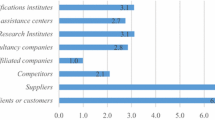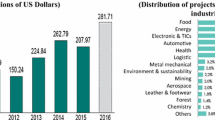Abstract
This paper advances our understanding of university-industry research and development (R&D) collaborations. These strategic relationships are a dimension of entrepreneurial activity, and they are thus important drivers of economic growth and development. Business collaboration with universities increases the efficiency and effectiveness of industrial investments. Previous studies have found that universities are more likely to collaborate with industry if the business is mature and large, is engaged in exploratory internal R&D, and there are not major intellectual property (IP) issues between both parties. Businesses gain from such collaborations through increased commercialisation probabilities and economies of technological scope. Based on publicly available data collected by the Science-to-Business Marketing Research Centre of Germany as part of a European Commission project, our paper focuses on two key questions. First, why are there cross-country differences in the extent to which universities collaborate with business in R&D? Second, are there covariates with these differences that might offer insight into policy prescriptions and policy levers for enhancing the extent to which such collaboration takes place? We find that access is positive and statistically significant in relation to fostering university-business R&D collaborations. Our results, albeit that they are tempered by a small sample of data, have implications how national innovation systems support further harmonization of IP regimes across universities and how universities prioritize their own investments and incentives.

Similar content being viewed by others
Notes
HEIs refer to all types of formally recognized institutions that provide higher education. Among those recognized by relevant national/regional authorities are: universities, universities of applied sciences, polytechnics /technical universities, and colleges and tertiary schools (Davey et al. 2011, p. 7).
Over 3,000 HEIs participated in the study; it resulted in a sampling population of 6,280 academics and HEI representatives (Davey et al. 2011, p. 7).
Each country study is titled “The State of University-Business Cooperation in [the country], and each report is available at http://www.ub-cooperation.eu/index/[the country].
Other dimensions of collaboration summarized in the report included mobility of academics, mobility of students, commercialization of R&D results, curriculum development and delivery, lifelong learning, entrepreneurship, and governance. It is important to emphasize that responses to this question is from the perspective of the HEI.
We see this fact being in concert with the premise that motivated the S2BMRC study for the European Commission, as quoted above.
See Cunningham et al. (2014) for a parallel discussion of knowledge transfer from universities and public institutions.
Other country-specific examples are in OECD (2013).
Bonaccorsi et al. (forthcoming) suggest that the knowledge conditions external to the university may influence university-industry collaborations. Their scholarship not only motivates the inclusion of this variable but also complements our recommendations in Section V below.
A Tobit specification is appropriate because the variable RDCollab has a Likert scale upper bound of 10.
This recommendation may be overly optimistic. As Hülsbeck et al. (2013) have discussed from the perspective of Germany, most technology transfer offices at public universities are occupied with individuals with little experience of specific human capital in the natural sciences.
References
Bercovitz, J. E. L., & Feldman, M. P. (2007). Fishing upstream: firm innovation strategy and university research alliances. Research Policy, 36, 930–948.
Boardman, P. C., & Corley, E. A. (2008). University research centers and the composition of research collaborations. Research Policy, 37, 900–913.
Bonaccorsi, A., Colombo, M. G., Guerini, M., & Rossi-Lamastra, C. (forthcoming). The impact of local and external university knowledge on the creation of knowledge-intensive firms: evidence from the Italian case. Small Business Economics. doi:10.1007/s11187-013-9536-2.
Borras, S. (2004). System of innovation theory and the European Union. Science and Public Policy, 31(6), 425–433.
Cohen, W. M., Florida, R., Randazzese, L., & Walsh, J. (1997). Industry and the academy: Uneasy partners in the cause of technological advance. In R. Noll (Ed.), Challenge to the University (pp. 171–200). Washington, DC: Brookings Institution Press.
Cunningham, J., O’Reilly, P., O’Kane, C., & Mangematin, V. (2014). The inhibiting factors that principal investigators experience in leading publicly funded research. Journal of Technology Transfer, 3, 93–110.
Davey, T., Baaken, T., Galán-Muros, V., & Meerman, A. (2011). Study on the cooperation between higher education institutions and public and private organisations in Europe, European Commission, DG Education and Culture, Brussels, Belgium.
European Commission (2010). Communication from the Commission Europe 2020 a strategy for smart, sustainable and inclusive growth, Brussels.
European Commission (2013). Commercialising public research: New trends and strategies, Brussels.
Fontana, R., Geuna, A., & Matt, M. (2006). Factors affecting university-industry R&D projects: the importance of searching, screening and signaling. Research Policy, 35, 309–323.
Georghiou, L. (2001). Evolving frameworks for European collaboration in research and technology. Research Policy, 30, 891–903.
Graff, G., Heimen, A., & Zilberman, D. (2002). University research and offices of technology transfer. California Management Review, 45, 88–115.
Hall, B. H. (2004). University-industry research partnerships in the United States. In J. Contzen, D. Gibson, & M. V. Heitor (Eds.), Rethinking science systems and innovation policies (pp. 1–31). West Lafayette: Purdue University Press.
Hall, B. H., Link, A. N., & Scott, J. T. (2001). Barriers inhibiting industry from partnering with universities: evidence from the advanced technology program. Journal of Technology Transfer, 26, 87–98.
Hall, B. H., Link, A. N., & Scott, J. T. (2003). Universities as research partners. Review of Economics and Statistics, 85, 485–491.
Hülsbeck, M., Lehmann, E. E., & Starnecker, A. (2013). Performance of technology transfer offices in Germany. Journal of Technology Transfer, 38, 199–215.
Kaiser, R., & Prange, H. (2004). Managing diversity in a system of multi-level governance: the open method of co-ordination in innovation policy. Journal of European Public Policy, 11, 249–266.
Lee, Y. (2000). The sustainability of university-industry research collaboration: an empirical assessment. Journal of Technology Transfer, 25(2), 111–131.
Lemola, T. (2002). Convergence of national science and technology policies: the case of finland. Research Policy, 3, 1481–1490.
Leyden, D. P., & Link, A. N. (2013). Knowledge spillovers, collective entrepreneurship, and economic growth: the role of universities. Small Business Economics, 41, 797–817.
Leyden, D. P., & Link, A. N. (2014). Public sector entrepreneurship. New York: Oxford University Press (in production).
Link, A. N., & Rees, J. (1990). Firm size, university-based research, and the returns to R&D. Small Business Economics, 2, 25–31.
Link, A. N., & Ruhm, C. J. (2009). Bringing science to market: commercializing from NIH SBIR awards. Economics of Innovation and New Technology, 18, 381–402.
Link, A. N., & Wessner, C. W. (2011). Universities as research partners: Entrepreneurial explorations and exploitations. In D. Audretsch (Ed.), Handbook of research on innovation and entrepreneurship (pp. 290–299). London: Edward Elgar Publishing.
Link, A. N., Siegel, D. S., & Bozeman, B. (2007). An empirical analysis of the propensity of academics to engage in informal technology transfer. Industrial and Corporate Change, 16, 641–655.
Mytelka, L. K., & Smith, K. (2002). Policy learning and innovation theory: an interactive and co-evolving process. Research Policy, 31, 1467–1479.
OECD (2013). Commercialising public research, new trends and strategies, Paris.
Science-to-Business Marketing Research Centre (S2BMRC, 2011). The State of European University-Business Cooperation Final Report - Study on the Cooperation between Higher Education Institutions and Public and Private Organisations in Europe, Münster, Germany.
Sheehan, J., & Wyckoff, A. (2003). “Targeting R&D: Economic and policy omplications of increasing R&D spending,” STI Working Paper 2003/8, Science and Innovation Unit, OECD, Paris.
Siegel, D. S., Waldman, D., & Link, A. N. (2003). Assessing the impact of organizational practices on the relative productivity of university technology transfer offices: an exploratory study. Research Policy, 32, 27–48.
Soete, L. (2007). From industrial to innovation policy. Journal of Industrial Competitive Trade, 7, 273–284.
Storey, D. J., & Tether, B. S. (1998). Public policy measure to support new technology based firms in the European Union. Research Policy, 26, 1037–1057.
Stuart, T. E., Ozdemir, S. Z., & Ding, W. W. (2007). Vertical alliance networks: the case of university-biotechnology-pharmaceutical alliance chains. Research Policy, 36, 477–498.
Thursby, J. G., Jensen, R., & Thursby, M. C. (2001). Objectives, characteristics and outcomes of university licensing: a survey of major U.S. universities. Journal of Technology Transfer, 26, 59–72.
Zeckhauser, R. (1996). The challenge of contracting for technological information. Proceedings of the National Academy of Science, 93, 12743–12748.
Author information
Authors and Affiliations
Corresponding author
Rights and permissions
About this article
Cite this article
Cunningham, J.A., Link, A.N. Fostering university-industry R&D collaborations in European Union countries. Int Entrep Manag J 11, 849–860 (2015). https://doi.org/10.1007/s11365-014-0317-4
Published:
Issue Date:
DOI: https://doi.org/10.1007/s11365-014-0317-4




